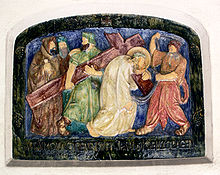Simon of Cyrene

Simon of Cyrene (often also: Kyrene or Cyrene) ( Hebrew שמעון, Hebrew Šimʿon , Tiberian Hebrew Šimʿôn ; Greek Σίμων Κυρηναῖος , Simōn Kyrēnaios ) is a figure of the passion story mentioned in the synoptic gospels . The Gospel of Mark describes him as "the father of Alexander and Rufus" ( Mk 15.21 EU ). Since these two names are of Greek and Roman origin, it is assumed that Simon could have been married to a Greek or Roman woman. On the other hand, the text of Luke's Gospel suggests that he was a simple field worker ( Lk 23.26 EU ). Simon was on his way home when a group of Roman soldiers forced him to carry the cross of the condemned Jesus of Nazareth ( Mt 27.32 EU ).
This scene can be found in the traditional 14 Christian Stations of the Cross , usually as the fifth or seventh scene as part of Christ's carrying the cross . The question of how far Simon had to carry the cross remains unanswered in the Gospels. The Gospel of John does not mention him.
According to Christian tradition, he is the first black saint because of his traditional Libyan descent.
According to the church father Irenaeus of Lyons , the Gnostic heretic Basilides of Alexandria represented the doctrine that it was actually Simon of Cyrene who was crucified and not Jesus because Jesus had assumed the form of Simon and vice versa ( docetism ). That it was not Jesus who was executed, but someone else who looked like him, is also stated in the Koran in Sura 4,157.
Web links
| personal data | |
|---|---|
| SURNAME | Simon of Cyrene |
| ALTERNATIVE NAMES | Simon of Cyrene; Simon of Cyrene |
| BRIEF DESCRIPTION | Person in the New Testament, had to carry the cross for Jesus of Nazareth |
| DATE OF BIRTH | 1st century BC BC or 1st century |
| DATE OF DEATH | 1st century |
